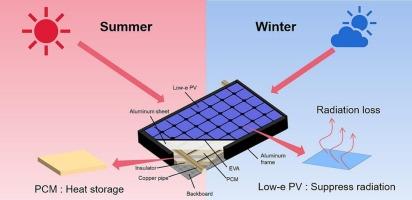相变材料光谱选择性光伏/热系统的实验与数值模拟分析
IF 10.9
1区 工程技术
Q1 ENERGY & FUELS
引用次数: 0
摘要
本文通过数值模拟研究了一种新型相变材料集成的低发射率光伏/热系统的性能。该系统解决了传统光伏/热系统的两个主要挑战:冬季的热量损失和夏季的过热。低发射率光伏电池减少了辐射热损失,而集成的相变材料通过在太阳辐射峰值期间吸收多余的热量并在较冷的时间间隔释放热量来调节系统的温度。模拟结果表明,冬季的热效率提高了12.4%,效率从24.06%提高到27.40%。在夏季,相变材料将PV电池温度从77.1°C降低到61.5°C,将电效率从15.48%提高到16.12%,提高了4.1%。参数分析表明,优化相变材料厚度、导热系数和潜热容可以显著提高系统性能。相变材料的最佳相变温度为35-40°C,确保了不同季节的平衡性能。这些结果突出了新型系统实现高效、全年能源利用的潜力。本文章由计算机程序翻译,如有差异,请以英文原文为准。

Experimental and numerical simulation analysis of spectrally selective photovoltaic/thermal system with phase change materials
This study investigates the performance of a novel low-emissivity photovoltaic/thermal system integrated with phase change materials through numerical simulation. The system addresses two key challenges of conventional photovoltaic/thermal systems: heat loss during winter and overheating in summer. The low-emissivity Photovoltaic cell reduces radiative heat loss, while the integrated phase change material regulates the system’s temperature by absorbing excess heat during periods of peak solar radiation and releasing it during cooler intervals. Simulation results demonstrate a 12.4 % enhancement in thermal efficiency during winter, with efficiency increasing from 24.06 % to 27.40 %. In summer, the phase change material reduces PV cell temperature from 77.1 °C to 61.5 °C, improving electrical efficiency by 4.1 %, from 15.48 % to 16.12 %. Parameter analysis indicates that optimizing phase change material thickness, thermal conductivity, and latent heat capacity significantly enhances system performance. The optimal phase transition temperature of the phase change material is identified as 35–40 °C, ensuring balanced performance throughout different seasons. These results highlight the potential of the novel systems to achieve efficient, year-round energy utilization.
求助全文
通过发布文献求助,成功后即可免费获取论文全文。
去求助
来源期刊

Energy Conversion and Management
工程技术-力学
CiteScore
19.00
自引率
11.50%
发文量
1304
审稿时长
17 days
期刊介绍:
The journal Energy Conversion and Management provides a forum for publishing original contributions and comprehensive technical review articles of interdisciplinary and original research on all important energy topics.
The topics considered include energy generation, utilization, conversion, storage, transmission, conservation, management and sustainability. These topics typically involve various types of energy such as mechanical, thermal, nuclear, chemical, electromagnetic, magnetic and electric. These energy types cover all known energy resources, including renewable resources (e.g., solar, bio, hydro, wind, geothermal and ocean energy), fossil fuels and nuclear resources.
 求助内容:
求助内容: 应助结果提醒方式:
应助结果提醒方式:


